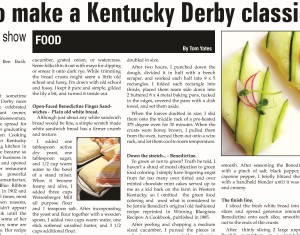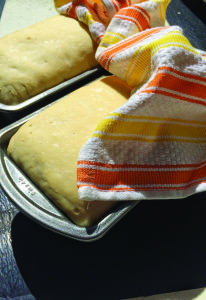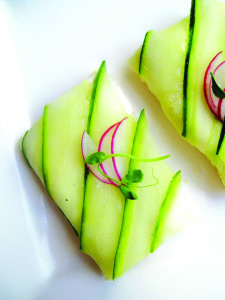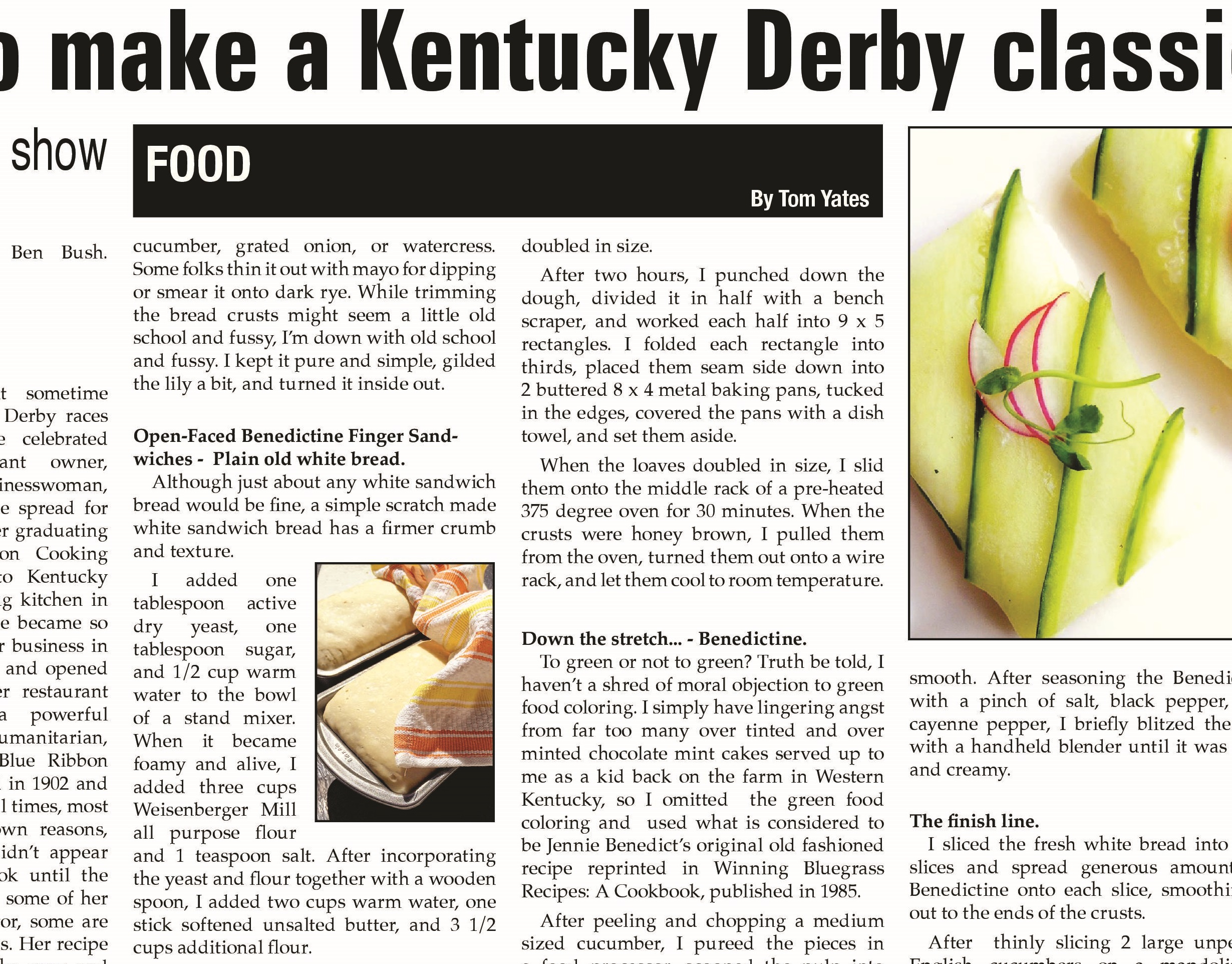Win, Place, or Show: How to make a Kentucky Derby classic
BY TOM YATES
1893-1899.


7 Horses.
7 Kentucky Derbies.
7 Winners.
It’s widely believed that sometime between the 1893 and 1899 Derby races Jennie Carter Benedict, the celebrated Louisville caterer, restaurant owner, cookbook author, and businesswoman, created her iconic Benedictine spread for crustless tea sandwiches. After graduating from Fannie Farmer’s Boston Cooking School, Benedict returned to Kentucky in 1893 and opened a catering kitchen in her back yard. Eventually, she became so successful that she moved her business in 1900 to downtown Louisville and opened a restaurant/tearoom. As her restaurant flourished, she became a powerful businesswoman, active humanitarian, and cookbook author. Her Blue Ribbon Cookbook was first published in 1902 and went on to be reprinted several times, most recently in 2008. For unknown reasons, her recipe for Benedictine didn’t appear in her Blue Ribbon Cookbook until the 2008 reprinted edition. While some of her recipes have fallen out of favor, some are still staples on Kentucky tables. Her recipe for Benedictine put her on the map and has stood the test of time. Along with mint juleps, country ham biscuits, and chocolate pecan bourbon pies, Benedictine is a Kentucky Derby tradition. You’d be hard pressed to not bump into variations of her cucumber-tinged, onion, cream cheese spread during any Derby day celebration.
In its purest form, Benedictine is a simple blend of cucumber juice, onion juice, cream cheese, and cayenne served on crustless white bread. Sure, it’s gotten dolled up over the years with the addition of bacon, grated cucumber, grated onion, or watercress. Some folks thin it out with mayo for dipping or smear it onto dark rye. While trimming the bread crusts might seem a little old school and fussy, I’m down with old school and fussy. I kept it pure and simple, gilded the lily a bit, and turned it inside out.
Open-Faced Benedictine Finger Sandwiches.
Plain old white bread.


I added 1 tablespoon active dry yeast, 1 tablespoon sugar, and 1/2 cup warm water to the bowl of a stand mixer. When it became foamy and alive, I added 3 cups Weisenberger Mill all purpose flour and 1 teaspoon salt. After incorporating the yeast and flour together with a wooden spoon, I added 2 cups warm water, 1 stick softened unsalted butter, and 3 1/2 cups additional flour.
I blended the mix, attached a dough hook to the mixer, and let it work for 3 minutes before scraping down the sides, setting the speed to medium, and the letting it rip for 10 minutes. When the shaggy dough turned smooth and tacky, I turned it out onto a bread board, kneaded it by hand for a few minutes, smoothed the dough into a ball, placed it into a buttered bowl, covered it with a dish towel, and set it aside until it doubled in size.
After 2 hours, I punched down the dough, divided it in half with a bench scraper, and worked each half into 9 x 5 rectangles. I folded each rectangle into thirds, placed them seam side down into 2 buttered 8 x 4 metal baking pans, tucked in the edges, covered the pans with a dish towel, and set them aside.
When the loaves doubled in size, I slid them onto the middle rack of a pre-heated 375 degree oven for 30 minutes. When the crusts were honey brown, I pulled them from the oven, turned them out onto a wire rack, and let them cool to room temperature.
Down the stretch…
Benedictine.
To green or not to green? Truth be told, I haven’t a shred of moral objection to green food coloring. I simply have lingering angst from far too many over tinted and over minted chocolate mint cakes served up to me as a kid back on the farm in Western Kentucky, so I omitted the green food coloring and used what is considered to be Jennie Benedict’s original old fashioned recipe reprinted in Winning Bluegrass Recipes: A Cookbook, published in 1985.
After peeling and chopping a medium sized cucumber, I pureed the pieces in a food processor, scooped the pulp into double lined cheesecloth, and squeezed the juice into a small bowl. Without cleaning the bowl of the processor, I repeated the process with a peeled, halved, and chopped medium sized onion. I added 3 tablespoons of the cucumber juice and 2 tablespoons of the onion juice to 8 ounces softened cream cheese and mashed it together with the times of a fork until it was somewhat smooth. After seasoning the Benedictine with a pinch of salt, black pepper, and cayenne pepper, I briefly blitzed the mix with a handheld blender until it was light and creamy.
The finish line.


After thinly slicing 2 large unpeeled English cucumbers on a mandolin (a vegetable peeler would have done the job), I cut them in half lengthwise and shingled the slices across the bread on a diagonal, overlapping the peeled ends over the centers until each bread slice was covered. Using a very sharp knife, I cut the crusts from the bread and sliced each piece in half before finishing with shaved radishes and Gary Farm pea tendrils.
Benedictine finger sandwiches.
Dressed for the Derby.
Light. Bright. Refreshing.
Win, Place, and Show.
This article also appears on page 11 of the May 2016 printed issue of Ace.
Subscribe to the Ace e-dition for Lexington news, arts, culture, and entertainment, delivered to your inbox every Thursday morning.











